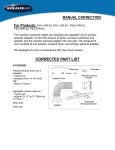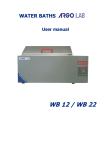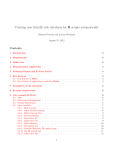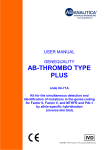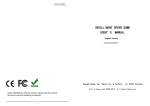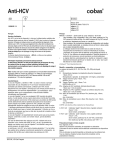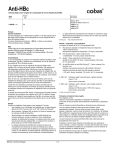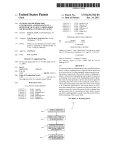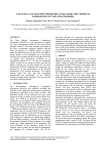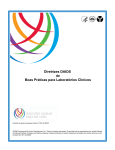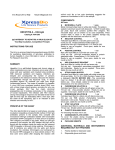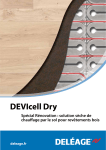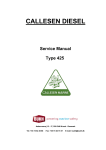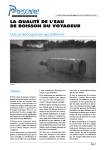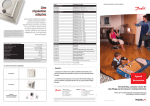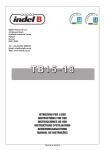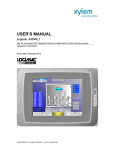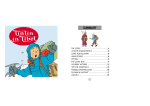Download HCV-TS - GALI spol. s ro
Transcript
USER MANUAL AMPLIQUALITY HCV-TS REF 03-07R-20 (20 test) REF 03-07R-XX (5 test) Hepatitis C Virus genotyping system by allele – specific reverse hybridization 0123 0123 Man_HCV-TS_03-07R_eR240912.doc 1. 1.1. PRODUCT INFORMATION 3 Intended use 3 2. KIT CONTENT 4 3. STORAGE AND STABILITY OF THE REAGENTS 5 4. WARNINGS AND PRECAUTIONS FOR USE 5 5. SAFETY RULES 7 5.1. General safety rules 7 5.2. Safety rules about the kit 8 6. 6.1. MATERIALS REQUIRED, BUT NOT PROVIDED Optional materials 9 9 7. INTRODUCTION 10 8. TEST PRINCIPLE 11 9. PRODUCT DESCRIPTION 11 10. STARTING SAMPLE: TYPE AND STORAGE 13 11. PROTOCOL 13 11.1. Procedural notes and preliminary Steps 13 11.2. Denaturation and Hybridization 11.2.1. Denaturation 11.2.2. Hybridization 15 15 15 11.3. Staining Protocol 16 12. QUALITY ASSESSMENT 18 13. INTERPRETATION OF THE RESULTS 19 14. TROUBLESHOOTING 21 15. DEVICE PERFORMANCE 22 15.1. Diagnostic specificity 22 15.2. Diagnostic sensitivity 22 15.3. Analitycal Sensitivity 23 15.4. Reproducibility 23 1 Man_HCV-TS_03-07R_eR240912.doc 16. DEVICE LIMITATIONS 23 17. DISPOSAL 24 18. TECHNICAL ASSISTANCE 24 19. REFERENCES AND SYMBOLS 25 20. SHORT PROTOCOL FOR DETECTION ON STRIPS:FAST GUIDE 27 Man_HCV-TS_03-07R_eR240912.doc 2 1. PRODUCT INFORMATION 1.1. Intended use The AMPLIQUALITY HCV-TS kit is an IVD for the identification of Hepatitis C Virus (HCV) genotypes 1-6 by reverse line blot. In most cases, additional information is available for the subtypes. This test is not to be used for viral screening or confirmation and must be used only for samples that have already been identified as positive. The kit has been validated with 5’-UTR region amplicons, obtained by: COBAS® TaqMan® HCV Test (manufactured by Roche Molecular System), including v2.0 for use with the High Pure System (Roche Molecular System) and COBAS®Ampliprep (Roche Molecular System). This manual refers to the following products: AMPLIQUALITY HCV-TS Includes all the reagents needed for the HCV genotyping by reverse line blot. Code Product 03-07R-20 AMPLIQUALITY HCV-TS 03-07R-XX AMPLIQUALITY HCV-TS 3 PKG 20 test 5 test Man_HCV-TS_03-07R_eR240912.doc 2. KIT CONTENT BOX R STORE AT + 2°C / + 8°C DESCRIPTION TUBE OR LID COLOUR 20 test 5 test 2 x 10 5 White 1 x 1 mL 1 x 1mL HYB-2 Red 1 x 25 mL 1 x 25 mL CON-D1 Yellow 1 x 50 mL 1 x 25 mL Streptavidin-Alkaline Phosphatase Conjugate CON Yellow 1 x 15 µL 1 x 15 µL Ready-to-use Rinse solution RIN Green 1 x 50 mL 1 x 50 mL NBT/BCIP Tinted bottle 4 tablets 1 tablet STOP Blue 1 x 25 mL 1 x 25 mL Hybridization and staining trays with 8 disposable incubation channels each 3 1 Transparent film for strip reading and interpretation of the results 1 1 Strip collection sheet 2 1 Nylon strips with specific probes Ready-to-use Denaturation Solution containing NaOH < 2% LABEL HCV–TS STRIP DEN Xi:irritant R 36/37/38 S26 Ready-to-use Hybridization Solution Ready-to-use Conjugate Diluent solution Substrate: NBT/BCIP in tablets for dissolving in water Ready-to-use Stop Solution containing Citric acid <0.5% BAG 1 STORE AT – 30°C / 20°C DESCRIPTION Hybridization activation reagent LABEL TUBE OR LID COLOUR 20 test 5 test HYB ACT Violet 1 x 70 uL 1 x 20 uL BAG 2 STORE AT – 30°C / 20°C DESCRIPTION Positive Control, 5’UTR amplicon of genotype HCV 2 Man_HCV-TS_03-07R_eR240912.doc LABEL TUBE OR LID COLOUR 20 test 5 test P-CTRL Blue 1 x 50 uL 1 x 20 uL 4 3. STORAGE AND STABILITY OF THE REAGENTS Each component of the kit must be stored according to the directions indicated on the label of each package. In particular: BOX R BAG 1 and 2 Store at + 2°C/+ 8°C Store at –30°C/ –20°C If stored at the recommended temperature, after the first opening all test reagents are stable until the expiration date indicated on the label. 4. WARNINGS AND PRECAUTIONS FOR USE • This product is for IN VITRO use only; • The kit should be handled by qualified investigators who are educated and trained in molecular biology techniques applied to diagnostics; • Before starting the kit procedure, read the instruction manual carefully and completely; • Keep the product away from light and heat sources; • Do not use any part of the kit past the expiration date; • In case of any doubts or questions about the storage conditions or box integrity, contact AB ANALITICA’s technical support at: [email protected] • The intra-laboratory temperature conditions should stay between + 15°C to + 28°C and the relative humidity must not exceed 80% during the entire test procedure. Temperatures and humidity that do not respect these ranges can lead to invalid results. In this case the test must be repeated; • It is important to include negative and positive controls in each experiment; • Store the kit away from any source of contaminating DNA, especially amplified nucleic acid; 5 Man_HCV-TS_03-07R_eR240912.doc • Wear personal protective apparel, throughout the assay procedure. • Use sterile filter tips and use a new tip every time a volume is dispensed. • Do not pipette with the mouth; • Avoid microbial contamination of the reagents; • Wash the work bench surfaces with 5% sodium hypochloride; • Use sterile disposable laboratory materials; • Do not wash and reuse trays or other disposable materials; • Do not cover the tray with nylon film or lids during all the steps of the entire protocol; • To prevent cross-contamination, do not interchange vial or bottle caps; • The reagents supplied in one kit must be considered as a single unit. Do not use or mix reagents from different lots or kits; • Reagent solutions are colourless and odourless; alterations in the physical appearance of the kit components may indicate instability or deterioration; • Organize the space into different areas: extraction, amplification, and detection; do not share instruments and consumables (pipettes, tips, tubes, etc) between them; change gloves between steps or more often if needed; laboratory coat and gloves must be worn in each area and removed before leaving that area. For guidance regarding good laboratory practice, you may also refer to Approved Guidelines, CLSI MM3-A2, Molecular diagnostics Methods for infectious diseases (CLSI, 2006). • Use all pipetting devices and instruments with care and follow the manufacturer’s instructions for calibration and quality control; • NBT/BCIP must not be exposed to direct light because it degrades easily. Once the tablets are dissolved in water, the BCIP/NBT solution must have an intense yellow colour. A colour change may indicate instability or deterioration of the reagent. Man_HCV-TS_03-07R_eR240912.doc 6 including disposable gloves, • 5. Store developed dry strips protected from light at room temperature. SAFETY RULES 5.1. General safety rules • Wear disposable gloves to handle the reagents and the clinical samples and wash your hands at the end of work; • Do not pipette with the mouth; • Since no known diagnostic method can assure the absence of infective agents, it is a good rule to consider every clinical sample as potentially infectious and handle it as such; • All the devices that directly touch the clinical samples must be considered as contaminated and disposed as such. In case of accidental spilling of the samples, clean up with 10% Sodium Hypochloride. The materials used to clean up must be disposed of in special containers for contaminated products; • Clinical samples, materials, and contaminated products should be disposed of after decontamination by: immersion in a solution of 5% Sodium Hypochloride (1 volume of 5% Sodium Hypochloride solution for every 10 volumes of contaminated fluid) for 30 min. OR autoclave at 121°C for at least 2 hours (NOTE: do n ot autoclave solutions containing Sodium Hypochloride!!). 7 Man_HCV-TS_03-07R_eR240912.doc 5.2. Safety rules about the kit The kit contains animal source reagents as casein and Streptavidin-Alkaline Phosphatase Conjugate. The risks derived from this kit are associated to the single components. Dangerous components: DEN SOLUTION: contains NaOH < 2% Description of risk: Hazard symbol(s): Xi R-phrase(s): 36/38 S-phrase(s): 26 Irritant RISK SENTENCES AND S SENTENCES R 36/37/38 S 26 Irritating to eyes and skin; In case of contact with eyes, rinse immediately with plenty of water and seek medical advice Material safety data sheet (SDS) of the kit is available upon request. Man_HCV-TS_03-07R_eR240912.doc 8 6. • • • • • • • • • • MATERIALS REQUIRED, BUT NOT PROVIDED Micropipettes (range: 0.5-10 µL; 2-20 µL; 20-100 µL; 100-1000 µL) and the corresponding filter tips; Automatic pipettor and sterile graduated pipettes; Aspirating system for liquids in the hybridization bath; Orbital shaker; Thermoshaker or waterbath (Dubnoff) able to reach and maintain 50°C ± 0.5°C; recommended shaking speed: 80 rpm for waterb ath and maximum 250 rpm for Thermoshaker; Disposable gloves; Falcon®-type tubes for preparation of the reagents; Distilled or deionized water, Tweezers; Calibrated thermometer. 6.1. Optional materials • Aspiration apparatus; • Equipment for automation of strips processing steps. For more details contact AB ANALITICA’s technical service at: e-mail ([email protected]), fax (+39 049-8709510) or phone line (tel. +39 049-761698). 9 Man_HCV-TS_03-07R_eR240912.doc 7. INTRODUCTION Hepatitis C virus belongs to the Flaviviridae family and its genome is characterized by a high degree of variablity. Infact, six main HCV genotypes (classified as genotypes 1-6 by Simmonds et al) are identified by phylogenetical and genome sequence analysis. The single HCV genotypes differ among them for about 30% of their nucleotide sequence (Simmonds et al, 2005). Each genotype is comprised of different subtypes, identified by the lowercase alphabet letters. The different HCV subtypes belonging to the same genotype differ among themselves for about 20% of their nucleotide sequence (Figure 1). Eventually, each HCV sybtype is comprised of many different variants or quasispecies that are due to random mutations that occur spontaneously with a certain frequency within the viral sybtype present in the single patient. Figure 1: HCV genotype and sybtype classification based on nucleotide sequence of the NS5B region, by P. Simmonds. The viral genotyping is of particular importance for the pharmacological treatment, as it indicates the duration and dosing of the treatment. There is a striking difference in geographical distribution of HCV genotypes: certain genotypes display a worldwide distribution, while others are found only in some geographical regions (Mellor et al., 1995). The HCV genotype prevalently found in Italy is the 1b genotype. There is no complete data regarding the HCV genotype prevalence in Europe, but it is most likely that two thirds of HCV infected patients present a genotype 1 infection; the rest of the patients present mainly genotype 2 and 3. Man_HCV-TS_03-07R_eR240912.doc 10 The genotype distribution may vary greatly also within a single geographic region in different patient populations: for example, the 3a HCV genotype is more frequent among the youngs and drug addicts. 8. TEST PRINCIPLE The AMPLIQUALITY HCV-TS kit is based on the reverse hybridization method, where the biotin-labeled amplicon of the viral 5’-UTR region is hybridized to the HCV genotype-specific oligonucleotide probes, immobilized on a nylon strip. 9. PRODUCT DESCRIPTION The AMPLIQUALITY HCV-TS kit is based on the reverse hybridization method where the specific probes, attached to the nylon strips, are hybridized with the amplified viral region (5’UTR). The correspondence between the each probe on the strip and the HCV genotypes is illustrated in the scheme below: PROBE Description PROBE N.1 Universal Sequence PROBE N.2 Genotype 1 PROBE N.3 Genotype 1 PROBE N.4 Genotype 1 b PROBE N.5 Genotype 1 b PROBE N.6 Genotype 1 a PROBE N.7 Genotype 2 PROBE N.8 Genotype 2 PROBE N.9 Genotype 2 PROBE N.10 Genotype 3 PROBE N.11 Genotype 3 PROBE N.12 Genotype 4 PROBE N.13 Genotype 4 PROBE N.14 Genotype 5 PROBE N.15 Genotype 6 11 Man_HCV-TS_03-07R_eR240912.doc The kit must be used with the 5’UTR viral region amplicon, obtained by: COBAS® TaqMan® HCV Test (manufactured by Roche Molecular System), including v2.0 for use with the High Pure System (Roche Molecular System) and COBAS®Ampliprep (Roche Molecular System). The kit can be used with the non-biotinylated amplicons obtained from COBAS® TaqMan® HCV Test, thanks to the use of the HYB ACT solution during the amplicon denaturation step. The strip includes a staining control band that monitors the success of the staining reaction. An universal HCV probe identifying an HCV positive sample regardless to the genotype in most of the cases is also present on the strip. The reading of the genotyping result is performed by overlaying the transparent film over the strip and by comparing the pattern of the bands present on the strip with the patterns indicated in the interpretation chart at the page 20. Man_HCV-TS_03-07R_eR240912.doc 12 10. STARTING SAMPLE: TYPE AND STORAGE The starting sample required for the assay is the amplification product of the viral 5’UTR region, obtained by: COBAS® TaqMan® HCV Test The amplicons must be stored immediately at – 30°C / – 20°C until use, in order to obtain a good genotyping assay. The use of AMPLIQUALITY HCV-TS on samples with a viral load below 15 IU / mL is not recommended. Note! The amplicons obtained with the Cobas TaqMan® HCV Test must be stored immediately at – 30°C / – 20°C and used f or the genotyping assay within 4 months. Avoid repeated freeze/thaw of the PCR product. Note! TaqMan® samples deriving from the automatic extraction step may contain black silica beads at the bottom of the tube. Avoid the contact and the uptake of the beads with pipette tip, as silica residues may interfere with the hybridization protocol. Therefore, a brief centrifugation step after the complete thawing of the sample is recommended, prior to uptake of an aliquot required for the genotyping analysis. 11. PROTOCOL 11.1. Procedural notes and preliminary Steps • Bring all reagents and strips to room temperature approximately 30 minutes before use; after use, return the HYB ACT and Positive Control solutions to – 20°C; put all the other reagents in the refrigerator; • HYB ACT solution is able to sustain 8-10 cycles of freeze/thaw. The performance of the kit after more than 10 cycles of HYB ACT solution freeze/thaw cycles was not tested. • Room temperature must be 20°C to 25°C; • Heat the bath or the thermalshaker at 50°C and ensure it maintains the given temperature during the entire procedure with an +/- 0.5°C error; 13 Man_HCV-TS_03-07R_eR240912.doc • If the temperature is too low, the assay may yield false positive results; if the temperature is too high, you may observe very weak signals or false negative results. Use a calibrated thermometer, because strict temperature control is necessary; • Avoid splashing water from the waterbath into the tray. Adjust the water level in the waterbath so that is between one-third and one-half the height of the tray; • To prevent the tray from sliding, immobilize it with weights if necessary. • Preheat the HYB-2 Solution and the CON-D1 Solution to 50°C ± 0.5°C in the bath; • Use tweezers to handle strips. Do not touch strips with your hands as the oils from your hands could interfere with hybridization and colour development; • It is important to maintain the link between the TaqMan® amplification sample and strip. Use only pencil to write above the marker line on the strip. Man_HCV-TS_03-07R_eR240912.doc 14 11.2. Denaturation and Hybridization 11.2.1. Denaturation Stabilize the temperature of the water bath or thermal shaker to 50°C ± 0.5°C. Preheat the HYB-2 Solution and the CON-D1 Solution to 50°C ± 0.5°C in the bath. • TaqMan® Roche amplicon: This amplicon must be denatured before starting the hybridization step. HYB-ACT solution must be added to allow the biotinylation of the amplicon. Mix the amplicon and the reagents in a tube as indicated in the table below: Genotyping starting from TaqMan® Roche amplicon TaqMan® Roche amplicon DEN Solution HYB ACT Solution 10 uL 20 uL 2.5 uL Include in each run one HCV positive control (P-CTRL, included in the kit) and one negative control (a negative TaqMan® sample). The positive control, included in the kit, is not biotinylated and must be denaturated following the same procedure for the TaqMan® Roche amplicon samples. P-CTRL is able to sustain 5 cycles of freeze/thaw. The performance of the PCTRL after more than 5 cycles of freeze/thaw was not tested. Incubate at room temperature for 5 minutes. Use the entire volume of the denatured amplicon in the hybridization step. 11.2.2. Hybridization • Take the strips with tweezers and place them on a clean surface. Number them above the positioning line with a pencil. Always wear gloves when handling the strips. • Place the tray in the thermobath or in the thermal shaker. In case the thermobath is used, make sure the level of water is half-height the tray (the water of the thermobath must absolutely not enter inside the tray). 15 Man_HCV-TS_03-07R_eR240912.doc • Add 1 mL of the preheated HYB-2 Solution to each used channel and place a strip in each one with the tweezers. The strips must be completely immersed in the solution and the side with the probes attached (identifiable by the presence of a black line) must be facing up. In case the strip turns upside down while placing in the liquid, use the tweezers to put it in the correct orientation. • Add the denatured amplicon to each channel, as indicated above; • Incubate for 60 min ± 2 min at 50°C ± 0.5°C agitating delicately. Set the waterbath approximately at 80 rpm and max 250 rpm for the thermal shaker. • Immobilize the tray if necessary. Ensure that each strip remains completely submerged and moves freely. 11.3. Staining Protocol • Dilute the streptavidine-alcaline phosphatase conjugate (CON Solution) shortly before the end of the incubation as follows: For N samples mix: - N x 0.5 µL of CON Solution - N x 1 mL of preheated CON-D1 Solution • Aspirate the hybridization liquid completely, then add 1 mL of preheated CON-D1 solution; put the tray back into the thermal bath or thermal shaker at 50°C ± 0.5°C for 2 minutes , agitating gently. • Aspirate the liquid from the channels completely and add 1 mL of streptavidine-alcaline phosphatase conjugate, previously diluted in the preheated CON-D1 Solution; incubate again at 50°C ± 0.5°C for 15 min ± 2 min, agitating gently. • Meanwhile, prepare the Stain Solution as indicated below: dissolve 1 tablet of NBT/BCIP in 10 mL of distilled water Attention: The quantity of stain solution obtained from one dissolved tablet of NBT/BCIP is sufficient for 10 strips! The obtained stain solution must be stored in the dark. Man_HCV-TS_03-07R_eR240912.doc 16 It is preferable to use a fresh solution, but if this is not possible it can be stored in the freezer at –30°C / –20°C for no more than 3 days in complete dark (it is recommended to wrap the tube with aluminium foil!). The frozen solution is reusable for only one cycle of freezing/thawing. • At the end of incubation with the conjugate aspirate all the liquid and add 1 mL of RIN Solution. Place the tray at room temperature under agitation for 2 minutes. • Aspirate the liquid completely and wash again with 1 mL of RIN Solution at room temperature under agitation for 2 minutes. • Empty the tray and add 1 mL of Stain Solution prepared previously. Incubate for 15-20 minutes in dark under agitation at room temperature. The incubation time can vary depending on the environmental conditions (ex. laboratory temperature) and the viral load of the sample. A prolonged incubation time can cause an increase in the background staining, which can interfere with the interpretation of the results • Empty the tray and stop the staining reaction by washing for 2 minutes with 1 mL of STOP Solution. • Aspirate the liquid and wash for 2 minutes with distilled water. • Remove the strips from the tray with the tweezers and let them dry between two pieces of paper towel. Dry the strips completely before reading the results. Store the developed and dried strips protected from light. 17 Man_HCV-TS_03-07R_eR240912.doc 12. QUALITY ASSESSMENT Attach the strips to a data reporting sheet or equivalent. Cover each strip with the transparent film (included in the kit), and align the Staining Control on the film with the one present on the strip. The stain control band, besides being a references for aligning the transparent film, is always positive when the strip was processed correctly. In particular, it confirms the efficiency of the conjugate bonds and the reaction of the substrate. The intensity of this line should be similar on each strip in the same assay run. Particularly the presence of the stain control band confirms the efficiency of the conjugate binding and its reaction with the substrate. A band is considered positive when a gray/brown band appear on the strip, at the end of the colour development procedure. Colour intensities between bands on a strip may differ from one band to the next. Before starting the interpretation of the results, check the positive and negative control results included in the run. 1. The negative control (TaqMan® negative sample) should have only the Staining Control band. There should be no apparent signal for any other band on the strip. 2. The positive control (P-CTRL), corresponding to genotype 2, should give positive results on the following bands: Staining Control band, band 1, band 7, 8, 9,13. If either control gives a pattern other than the one specified for that control, the run is invalid and must be repeated. Man_HCV-TS_03-07R_eR240912.doc 18 13. INTERPRETATION OF THE RESULTS Cover each strip with the transparent film (included in the kit), and align the Staining Control on the film with the one present on the strip. Compare the band patterns obtained on the strip with the ones indicated in the interpretation chart (Table 1). The presence of the stain control band confirms the efficiency of the conjugate binding and its reaction with the substrate. The presence of the Universal HCV Sequence indicates the presence of an HCV 5’UTR amplicon. Nevertheless, this probe may be absent in certain interpretation patterns. Each band pattern reported in the interpretation chart is indicated with an alphanumeric code (es. p1, p2,.. p23, etc), located in the bottom row of the table. The sole aim of this code is to facilitate the discrimination among the different band patterns belonging to the same genotype, and is not by any means related to the genotyping itself. In case in which the resulting band pattern is not present in the interpretation chart, the results cannot be interpreted. Another genotyping method (sequencing) may be required for the sample genotyping. In this case, we advise you to contact AB ANALITICA’s technical service at: e-mail ([email protected]), fax (+39 049-8709510) or phone line (tel. +39 049-761698). NOTE: The band pattern p13, corresponding to the genotype 1a/1b, identifies a 5’UTR sequence that is present both in 1a and 1b genotypes. Thus, the viral subtyping is not possible for this pattern. The band pattern p15, corresponding to the genotype 1, identifies a 5’UTR sequence that occurs in the 1a genotype in 80% of the cases, and in the 1b genotype in the remaining 20% . Thus, such pattern does not provide the key information required for the sample subtyping. 19 Man_HCV-TS_03-07R_eR240912.doc Table 1: Interpretation chart of the possible genotyping patterns. 1b 1 x x 2 x x x x x 3 x x x x x x x x x x 4 x x x x x x x x x x x x x x x x x x x x x x x x 2a/2c 2b x x x x x x x x x x x x x x x x 5 2 x x x x x x x 3 4a 4 x x x x x x x x x x x x x x x GENOTYPE 6 5a x x x x x x x x x x x x x x x x x 8 x x 4 5 x x x x x x x x x x x x x x x x x x 12 x x x x x x x 14 x p56 p53 p52 p51 p50 p49 p48 p47 p46 p45 p44 p43 p42 p41 p40 p39 p38 p37 p36 p35 p34 p33 p32 p31 p30 p29 p28 p27 p26 p25 p24 p23 p22 p21 p20 p19 p18 p17 p15 p14 p13 p12 p11 p9 p10 p8 p7 p6 p5 p55 x x 20 13 x 15 p4 7 x x x x x x x x x x x p3 x 10 14 p2 6 11 x p1 x x x x 12 Man_HCV-TS_03-07R_eR240912.doc x 9 x x x x x x x x 11 x 3 8 x x x x x x x x x x x x x x 10 x 2 x x x x x x x 9 1 x x x x x 7 6 6a o 6b x x x x x x x x x x x x x x x 13 5 x x x 3a GENOTYPE 4 p54 6 x x x 1 1a/1b GENOTYPE 3 n. probe 1a GENOTYPE 2 15 p58 GENOTYPE 1 p57 n. probe HCV-TS Interpretation Chart 14. TROUBLESHOOTING 1. Weak or no bands, also for the stain control band in all of the strips – Too few or no conjugate or substrate used. – Substrate not suitable, due to too many freeze/thaw cycles. 2. Heterogeneous Staining – The strips were not fully submerged during various incubation steps. – The tray was not shaken enough during hybridization. 3. No band except the Stain control band – Check the HCV positivity of the sample before reverse hybridization by agarose gel electrophoresis; – If the sample turns out positive in the agarose gel electrophoresis, another genotyping method (sequencing) is required. In this case, we advise you to contact AB ANALITICA’s technical service: [email protected], fax (+39) 049-8709510, or tel. (+39) 049761698). 4. Unexpected Results In case in which the genotyping run presents anomalous staining of the strip (i.e. strong background, generic non specificity, etc.), some of the following conditions may have occurred: – Wrong incubation temperature. – HYB-2 and/or CON-D1 Solution were not preheated properly. – Contamination of the contiguous channels due to the sprinkles during the first washing steps. – A rapid and intense developing of a band may occur, depending on the amount of the amplified DNA and the specific reaction conditions. In this case, interrupt the substrate incubation immediately, in order to prevent the developing of the cross-hybridization bands. For any problem or question, contact AB ANALITICA’s technical service: [email protected], fax (+39) 049-8709510, or tel. (+39) 049-761698). 21 Man_HCV-TS_03-07R_eR240912.doc 15. DEVICE PERFORMANCE Most specimens used to define the performance characteristics of AMPLIQUALITY HCV-TS kit were collected in Italy from HCV-positive subjects. The positivity of these samples was confirmed by amplification with the COBAS® TaqMan® HCV kit test; the PCR product obtained were used for genotyping with AMPLIQUALITY HCV-TS. The results were compared with results obtained in the sequencing of NS5b region. Positive samples of genotypes HCV 1 (subtypes a and b), HCV 2, 3, 4,5 and 6 were tested according to the Common Technical Specification, 2009/886/EC of 27 November 2009. Not every subtype of every genotype was tested. 15.1. Diagnostic specificity 100 5’UTR amplicons, obtained with COBAS® TaqMan® HCV Test from HCV negative RNA samples, were analyzed with the AMPLIQUALITY HCV-TS kit. The absence of the HCV genotyping bands was confirmed in all the amplicons obtained from the negative samples. The results allowed to establish a Disgnostic specificity value of 100%. 15.2. Diagnostic sensitivity The ability of the AMPLIQUALITY HCV-TS kit to correctly assign the genotypes to the tested samples, was evaluated on 212 HCV RNA positive samples amplified with COBAS® TaqMan® HCV Test. Samples were selected to be representative of HCV genotypes 1-6 and, according to the Common Technical Specification, 2009/886/EC of 27 November 2009, their viral load spanned from 15 to 6 x 107 IU / mL. The genotyping results obtained were compared with those obtained on the same samples by sequencing of viral NS5b region. The analysis was conducted at the genotype level and at the subtypes level considering subtypes a and b of genotype 1 separately. All the 212 strips were interpretable and consistent in terms of genotype with the reference method (212/212). Thus the DIAGNOSTIC SENSITIVITY at the genotype level resulted of 100%. The DIAGNOSTIC SENSITIVITY at the subtype level for 1 a and 1 b genotyping resulted of 95,7%. Man_HCV-TS_03-07R_eR240912.doc 22 15.3. Analitycal Sensitivity To assess the sensitivity limit a reference HCV-RNA preparation was used (PEI Reference Preparation HCV-RNA) it was calibrated against the WHO International Standard HCV-RNA using four different quantitative NAT assay. Serial dilutions of the quantified reference standard, ranging from 4000 to 200 IU/ml of viral genome, were tested in 2 separate anaysis in order to determine the analytical sensitivity. After extraction and amplification the amplicons were analysed on strips in eight replicates. The analytical sensitivity limit of the AMPLIQUALITY HCV-TS kit as calculated by a Probit analysis is 1240 UI/ml of viral genome. 15.4. Reproducibility Reproducibility of the device AMPLIQUALITY HCV-TS was assessed in combination with the COBAS® TaqMan® HCV Test. HCV RNA positive samples were amplified in three independent sessions with the COBAS® TaqMan® system. Three sessions of genotyping were performed using each amplificate (in triplicate) with three different lots of AMPLIQUALITY HCV-TS kits, in order to verify the inter-assay and intra-assay variability. No difference in the data were observed between lots, replicate of the same sample, or genotypes. 16. DEVICE LIMITATIONS This genotyping test functions only within the limits of the genic region in which the probes were selected. Thus, the sequencing of this region may complete the analysis in the uncertain cases. As with any detection system based on the nucleic acid hybridization, it is possible that unexpected results occur, due to the presence of the mutations in the genic sequences that fall in the region in which the probes were designed and for which the test was not developed. The use of this kit is limited to the qualified personnel with good knowledge in molecular biology techniques. The AMPLIQUALITY HCV-TS kit is designed for genotyping from 5'UTR PCR product obtained with COBAS TaqMan ® HCV Test ® and COBAS® 23 Man_HCV-TS_03-07R_eR240912.doc TaqMan® HCV Test v2.0 for use with the High Pure System and COBAS®Ampliprep. The performance characteristics have not been defined using other HCV amplification kit. In rare cases a phenomenon of inhibition was observed, due to the potential presence of inhibitors in the COBAS ® TaqMan ® HCV PCR product. In order to successfully genotype the sample, it was necessary to repeat the amplification of the sample. The band pattern p13, corresponding to genotype 1a/1b, identifies a 5’UTR sequence that is present both in 1a and 1b genotypes. Thus, the viral subtyping is not possible for this pattern. The band pattern p15, corresponding to genotype 1, identifies a 5’UTR sequence that occurs in the 1a genotype in 80% of the cases, and in the 1b genotype in the remaining 20% . Thus, such pattern does not provide the key information required for subtyping the sample. In rare cases, uninterpretable patterns may appear. This may be due to sequence heterogeneity of the HCV genome, mixed infections or cross contaminations, recombinant HCV isolates (Kalinina O. et al., 2002). 17. DISPOSAL Dispose of hazardous or biologically contaminated materials according to the practices of your institution. Discard all materials in a safe and acceptable manner, and in accordance with proper laboratory practices and local environmental regulations. 18. TECHNICAL ASSISTANCE For customer support, please contact AB ANALITICA’s technical service: [email protected], fax (+39) 049-8709510, or tel. (+39) 049-761698). Man_HCV-TS_03-07R_eR240912.doc 24 19. REFERENCES AND SYMBOLS Clinical and Laboratory Standards Institute (CLSI, formerly NCCLS) Molecular Diagnostics Methods for Infectious Diseases: Approved GuidelineSecond Edition (MM3-A2).2006; 26 (8). Kalinina O., Norder H, Mukomolov S. and Magnius LO. A Natural intergenotypic recombinant of hepatitis C virus identified in St. Petersburg. J. Virol. 2002. 76: 4034-4043. Mellor J, Holmes E. C., Jarvis L. M., Yap P. L., Simmonds P. and The International HCV Collaborative Study group, Jornal of General virology, 76, 2493-2507, 1995. Saiki RK, Scharf S, Faloona F, Mullis KB, Horn GT, Erlich HA and Arnheim N, Science 230, 1350-1354, 1985 Simmonds P, Bukh J., combet C., Deléage G., Enomoto N., Feinstone S., Halfon P., Inchauspè G., Kuiken C., Maertens G., Mizokami M., Murphy D. G., Okamoto H, Powlotsky JM, Penin F, Sablon E, Stuyver LJ, Thiel HJ, Weinwe AJ, Widell A, Hepathology 42, 962-973, 2005. 25 Man_HCV-TS_03-07R_eR240912.doc SYMBOLS Symbol Description CE Mark with identification number of notified body 0123 Consult Instruction for use Caution, consult accompanying documents Keep away from sunlight Temperature limitations Use by date Manufacturer Batch code Catalogue number In vitro diagnostic medical device Contains sufficient for 20 test Xi: Irritant Man_HCV-TS_03-07R_eR240912.doc 26 20. SHORT PROTOCOL FOR DETECTION ON STRIPS:FAST GUIDE INCUBATION CONDITIONS INCUBATION TIME (MINUTES) Room temperature 5’ 50°C with shaking 60’ 50°C with shaking 2’ CON-D1 preheated to 50°C) 50°C with shaking 15’ 5) Rinse RIN Room temperature with shaking 2’ 6) Rinse RIN Room temperature with shaking 2’ (dissolve 1 tablet NBT/BCIP in 10 ml H2O distillata) Room temperature with shaking IN DARK 15’-20’ STOP Room temperature with shaking 2’ Distilled water Room temperature with shaking 2’ STEP 1) Amplicon denaturation 2) Hybridization 3) Stringent Wash 4) Streptavidine-AP Conjugate incubation REAGENTS REQUIRED 10 µl TaqMan® amplicon + 2.5 µl HYB ACT + 20 µl DEN HYB-2 (preheated to 50°C) + denatured amplicons CON-D1 (preheated to 50°C) CON diluted (0.5 µl CON + 1 ml STAINING 7) Staining reaction 8) Stopping of the staining reaction 9) Final rinse This short protocol summary is not complete. For complete instructions, read chapter 11 carefully (page 13-17). Man_HCV-TS_03-07R_eR240912.doc Man_HCV-TS_03-07R_eR240912.doc 28 AB ANALITICA srl Via Svizzera 16 - 35127 PADOVA, (ITALY) Tel +39 049 761698 - Fax +39 049 8709510 e-mail: [email protected]
































